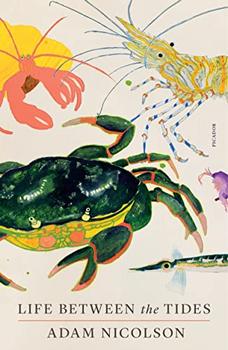Summary | Excerpt | Reviews | Beyond the book | Read-Alikes | Genres & Themes | Author Bio

Life Between the Tides is one of those rare books that is truly interdisciplinary, transcending genres to effortlessly reveal the wondrous underlying nature of the mundane and overlooked. In doing so, Adam Nicolson unlocks and shares profound truths about the meaning of life. The book initially appears to be a simple naturalist exploration of the biology within tidal pools — small ponds of seawater surrounded by rock or sand created when the tide retreats. He bashes in rocks with a sledgehammer to form his own tidal pools and observes the drama as the organisms fight with one another, and in quieter moments, contemplates prawns, winkles and crabs for long stretches at a time.
It's extremely interesting to explore each of these small creatures in turn, as well as the impact that the tides have upon their brief life cycles. But then Nicolson begins to draw us into their existence on a deeper level. Even when describing and sharing every minute detail of seemingly alien life forms — such as sandhoppers, which are tiny antennaed buglike creatures — he reveals their being in a way that builds connection, urging us to recognize our shared life and mortality. Their lives are more transient, but no less special, and part of the flux of life and rhythm of the tides and the greater universe. In sharing this connection, we begin to understand our co-presence with anemones, kelp and other beings that we had most likely never considered on such intimate and equal footing.
While drawing us into these complex, interrelated worlds and lives, Nicolson shares philosophies about pursuing the meaning of life through love, virtue and care. The approach is not one of traditional human societal progress, guided by external and indivudal goals; rather, transcendental meaning is found through diminishment and removal of our ego and consciousness. Virtue and love arises from "pierc[ing] the veil of selfish consciousness and join[ing] the world as it really is," by accepting the ebb and flow of the tides and the small creatures that pass through their flux. Nicolson has shared the value that nature can provide to us, since it allows us to "amend our consciousness" and see how much larger the natural world is, and to understand our "co-presence" with everything else within.
Fundamentally, "care and true being are indivisible." Care is derived from a "diminution of the thinking self" so that we can begin to understand the "autonomy of other life" — starting with the sandhopper, prawn, winkle, crab and anemone. This is a lesson that slowly unfolds through the different chapters with gentle and unflagging fascination and delight. Nicolson expands our sense of wonder and "being-with" (his term for this brand of interconnectedness) toward other entities as a form of love throughout this book. He may start off with the animals, but then he expands this amazement to the actual space, rock and water that surround us, as well as the intangible history, culture and belief created over time.
He also recreates that sense of wonder and kinship with the immense, just as he does with the minute tidal pool creatures. He explores the actual planetary motions, describing a dance between the moon and earth that causes the tide's massive imperceptible wave of water on our planet as a "form of longing, a mysterious affinity between things at a distance from each other." It is the same interconnectedness that exists between us and the other living creatures in our world.
Ultimately, Nicolson sets out the true philosophical underpinning as to why it is important to preserve the world around us and all life that inhabits it. It is not for utilitarian purposes, but because the care and preservation of the balance and flux of the world is indivisible from our own existence. That very shared balance is what allows us to live a life of value and meaning.
![]() This review was originally published in The BookBrowse Review in March 2022, and has been updated for the
March 2023 edition.
Click here to go to this issue.
This review was originally published in The BookBrowse Review in March 2022, and has been updated for the
March 2023 edition.
Click here to go to this issue.

If you liked Life Between the Tides, try these:

by Hannah Stowe
Published 2025
A book to sweep you away from the shore, into a wild world of water, whale, storm, and starlight— to experience what it's like to sail for weeks at a time with life set to a new rhythm.

by Helen Czerski
Published 2024
A scientist's exploration of the "ocean engine"—the physics behind the ocean's systems—and why it matters.
Your guide toexceptional books
BookBrowse seeks out and recommends the best in contemporary fiction and nonfiction—books that not only engage and entertain but also deepen our understanding of ourselves and the world around us.